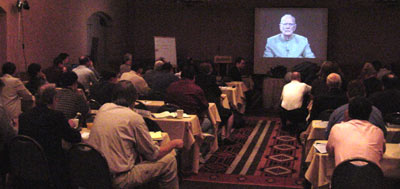The space elevator: going up? (part 2)by Jeff Foust
|
| “The length is not the challenge,” Kentucky’s Andrews said of making nanotube composite fibers. “It’s getting the strength.” |
To that end he and his colleagues have been working on developing multiwalled nanotubes, which as the name suggests are carbon nanotubes that contain multiple layers of carbon. They are currently able to produce 1.2 kilograms of such nanotubes a day, with a purity of at least 95 percent. Such nanotubes should have a tensile strength of at least 150 gigapascals (compared to steel’s 0.4 gigapascals), based on recent tests at the University of California Berkeley, and could be as high as 300 gigapascals. Andrews said that strength should be sufficient to make composite fibers with a strength of at least 100 gigapascals, the requirement for a space elevator.
A different approach is being undertaken by Yuntian Ted Zhu of Los Alamos. Rather than work with relatively short carbon nanotubes, a few microns long, he is trying to develop continuous lengths of nanotubes that could be woven into fabrics and threats. The continuous nanotubes, he believes, could get around some of the problems of using shorter nanotubes in composites, where the interface between the nanotube and the composite material can cause stress concentrations or become a point of weakness.
Attendees agreed, though, that nanotubes presented the only solution to the material requirements for a space elevator. “This is the long pole because it is new technology,” said Brad Edwards, director of research at the Institute for Scientific Research (ISR) and the leading developer of the new space elevator concept.
| Nanotubes “are not completely inert in mammalian tissue,” said Ron Morgan of Los Alamos. “Don’t be the guinea pig.” |
One issue the conference addressed that had not previously been widely contemplated is the environmental and health risks that nanotubes pose. Ron Morgan of Los Alamos noted that nanotubes could pose a health risk through skin irritation, ingestion, or inhalation. “The human body has never been subjected to materials like this,” he noted, saying the material most like nanotubes was asbestos, a known carcinogen. Animal tests of nanotubes are just beginning, he noted, and early results do show some adverse affects. “These are not completely inert in mammalian tissue,” he said. He urged researchers to treat the materials with caution, using fume hoods and other equipment to keep them from inhaling the material. “Don’t be the guinea pig.”
Other sessions of the conference tackled other technical issues, ranging from beaming power from the ground to vehicles on the elevator to the dynamics of the elevator cable itself. In a session about the “climbers” that would travel up the elevator, Laubscher noted that there has been very little technical work done to date on the technical design of these vehicles. “There are many aspects of the space elevator that no one has thought about,” he said.
